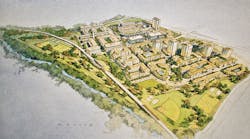San Diego State University unveils ambitious plan for stadium site
San Diego State University has unveiled a multibillion-dollar development proposal for 166 acres of land including and immediately surrounding the stadium that formerly housed the San Diego Chargers.
The plan, dubbed "SDSU Mission Valley," would provide housing for upper-division and graduate-level students, faculty and staff, along with workforce and affordable housing; a new multiuse stadium for collegiate athletics, professional sports, and other entertainment events; commercial office buildings to include innovation and research space; visitor-serving hotels and neighborhood-serving retail uses. Community parks, open space, and recreation fields account for more than 50 percent of the site, the university says.
“This is a once-in-a-lifetime opportunity to expand the university in a location that is both close to the main campus and large enough to accommodate the university’s growth needs,” said SDSU President Sally Roush. “It is a plan with the heart and spirit of a modern university campus that will serve higher education and the community’s aspirations for the site.”
The San Diego Union-Tribune reports that consultants value the project at $3 billion, but provided no breakdown for land acquisition or public improvements. The university plans to pay for the stadium without raising student fees or tapping state funds.
The land now is occupied by the 71,000-seat stadium that was known until last year as Qualcomm Stadium and was home to the NFL's San Diego Chargers. The team relocated to Los Angeles earlier this year, and the stadium has been renamed San Diego County Credit Union Stadium, or SDCCU Stadium. The university plays its home football games there.
The site design for the proposed development takes an “open space first” approach and fully incorporates access to public transportation.
The university plans to mitigate offsite traffic impacts by improving the local circulation network, as required by the California Environmental Quality Act, and in consultation with the City of San Diego and the community planning group.
According to Roush, the university is not daunted by the size and scope of the development plan.
“Over the past five years, SDSU has developed more than half a billion dollars in capital projects,” she said. “Whether it is through public-private partnerships, or bonds that would be paid back by revenue generated through the development, we have the resources for the purchase and development of this land.”
Representatives from the university will bring their vision for SDSU Mission Valley to the community and seek feedback from community groups, associations, and professional organizations.
About the Author
Mike Kennedy
Senior Editor
Mike Kennedy, senior editor, has written for AS&U on a wide range of educational issues since 1999.
